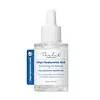What's inside
What's inside
 Key Ingredients
Key Ingredients

 Benefits
Benefits

 Concerns
Concerns

No concerns
 Ingredients Side-by-side
Ingredients Side-by-side

Water
Skin ConditioningButylene Glycol
HumectantGlycerin
HumectantGlyceryl Glucoside
HumectantGlycereth-26
HumectantSodium Hyaluronate
HumectantThamnolia Vermicularis Leaf Extract
Skin ConditioningSparassis Crispa Extract
Emulsion StabilisingXylitylglucoside
HumectantAnhydroxylitol
HumectantXylitol
HumectantGlucose
HumectantHydroxyethylcellulose
Emulsion StabilisingCarbomer
Emulsion StabilisingTromethamine
BufferingAllantoin
Skin ConditioningBoswellia Serrata Resin Extract
Smoothing1,2-Hexanediol
Skin ConditioningDisodium EDTA
Ethylhexylglycerin
Skin ConditioningWater, Butylene Glycol, Glycerin, Glyceryl Glucoside, Glycereth-26, Sodium Hyaluronate, Thamnolia Vermicularis Leaf Extract, Sparassis Crispa Extract, Xylitylglucoside, Anhydroxylitol, Xylitol, Glucose, Hydroxyethylcellulose, Carbomer, Tromethamine, Allantoin, Boswellia Serrata Resin Extract, 1,2-Hexanediol, Disodium EDTA, Ethylhexylglycerin
Bifida Ferment Lysate
Skin ConditioningPolyglycerin-3
HumectantMethylpropanediol
SolventDipropylene Glycol
Humectant1,2-Hexanediol
Skin ConditioningBetaine
HumectantPanthenol
Skin ConditioningNiacinamide
SmoothingCentella Asiatica Extract
CleansingTheobroma Cacao Seed Extract
AntioxidantFicus Carica Fruit Extract
HumectantArtemisia Princeps Leaf Extract
Skin ConditioningJuniperus Virginiana Oil
MaskingHydrogenated Lecithin
EmulsifyingCedrus Atlantica Bark Oil
MaskingAmyris Balsamifera Bark Oil
MaskingPogostemon Cablin Leaf Oil
MaskingWater
Skin ConditioningGlycerin
HumectantPolymethylsilsesquioxane
Acrylates/C10-30 Alkyl Acrylate Crosspolymer
Emulsion StabilisingOctyldodeceth-16
EmulsifyingTromethamine
BufferingFructooligosaccharides
HumectantButylene Glycol
HumectantXanthan Gum
EmulsifyingGlyceryl Polymethacrylate
Adenosine
Skin ConditioningDextrin
AbsorbentCopaifera Officinalis Resin
MaskingCeramide NP
Skin ConditioningLactobacillus Ferment Lysate
Skin ConditioningLactococcus Ferment
Skin ConditioningLactococcus Ferment Lysate
Skin ConditioningBifida Ferment Filtrate
Skin ConditioningSaccharomyces Ferment Filtrate
HumectantEthylhexylglycerin
Skin ConditioningBifida Ferment Lysate, Polyglycerin-3, Methylpropanediol, Dipropylene Glycol, 1,2-Hexanediol, Betaine, Panthenol, Niacinamide, Centella Asiatica Extract, Theobroma Cacao Seed Extract, Ficus Carica Fruit Extract, Artemisia Princeps Leaf Extract, Juniperus Virginiana Oil, Hydrogenated Lecithin, Cedrus Atlantica Bark Oil, Amyris Balsamifera Bark Oil, Pogostemon Cablin Leaf Oil, Water, Glycerin, Polymethylsilsesquioxane, Acrylates/C10-30 Alkyl Acrylate Crosspolymer, Octyldodeceth-16, Tromethamine, Fructooligosaccharides, Butylene Glycol, Xanthan Gum, Glyceryl Polymethacrylate, Adenosine, Dextrin, Copaifera Officinalis Resin, Ceramide NP, Lactobacillus Ferment Lysate, Lactococcus Ferment, Lactococcus Ferment Lysate, Bifida Ferment Filtrate, Saccharomyces Ferment Filtrate, Ethylhexylglycerin
Ingredients Explained
These ingredients are found in both products.
Ingredients higher up in an ingredient list are typically present in a larger amount.
1,2-Hexanediol is a synthetic liquid and another multi-functional powerhouse.
It is a:
- Humectant, drawing moisture into the skin
- Emollient, helping to soften skin
- Solvent, dispersing and stabilizing formulas
- Preservative booster, enhancing the antimicrobial activity of other preservatives
Butylene Glycol (or BG) is used within cosmetic products for a few different reasons:
Overall, Butylene Glycol is a safe and well-rounded ingredient that works well with other ingredients.
Though this ingredient works well with most skin types, some people with sensitive skin may experience a reaction such as allergic rashes, closed comedones, or itchiness.
Learn more about Butylene GlycolEthylhexylglycerin (we can't pronounce this either) is commonly used as a preservative and skin softener. It is derived from glyceryl.
You might see Ethylhexylglycerin often paired with other preservatives such as phenoxyethanol. Ethylhexylglycerin has been found to increase the effectiveness of these other preservatives.
Glycerin is already naturally found in your skin. It helps moisturize and protect your skin.
A study from 2016 found glycerin to be more effective as a humectant than AHAs and hyaluronic acid.
As a humectant, it helps the skin stay hydrated by pulling moisture to your skin. The low molecular weight of glycerin allows it to pull moisture into the deeper layers of your skin.
Hydrated skin improves your skin barrier; Your skin barrier helps protect against irritants and bacteria.
Glycerin has also been found to have antimicrobial and antiviral properties. Due to these properties, glycerin is often used in wound and burn treatments.
In cosmetics, glycerin is usually derived from plants such as soybean or palm. However, it can also be sourced from animals, such as tallow or animal fat.
This ingredient is organic, colorless, odorless, and non-toxic.
Glycerin is the name for this ingredient in American English. British English uses Glycerol/Glycerine.
Learn more about GlycerinTromethamine helps balance the pH and improve the texture of a product. It is synthetically created.
As an emulsifier, Tromethamine prevents oil and water ingredients from separating. This helps stabilize the product and elongate a product's shelf life. Tromethamine also makes a product thicker.
Tromethamine helps balance the pH level of a product. Normal pH level of skin is slightly acidic (~4.75-5.5). The acidity of our skin is maintained by our glands and skin biome. Being slightly acidic allows our skin to create an "acid mantle". This acid mantle is a thin barrier that protects our skin from bacteria and contaminants.
Oral Tromethanmine is an anti-inflammatory drug but plays the role of masking, adding fragrance, and/or balancing pH in skincare.
1,3-Propanediol, 2-amino-2-(hydroxymethyl)-
Learn more about TromethamineWater. It's the most common cosmetic ingredient of all. You'll usually see it at the top of ingredient lists, meaning that it makes up the largest part of the product.
So why is it so popular? Water most often acts as a solvent - this means that it helps dissolve other ingredients into the formulation.
You'll also recognize water as that liquid we all need to stay alive. If you see this, drink a glass of water. Stay hydrated!
Learn more about Water